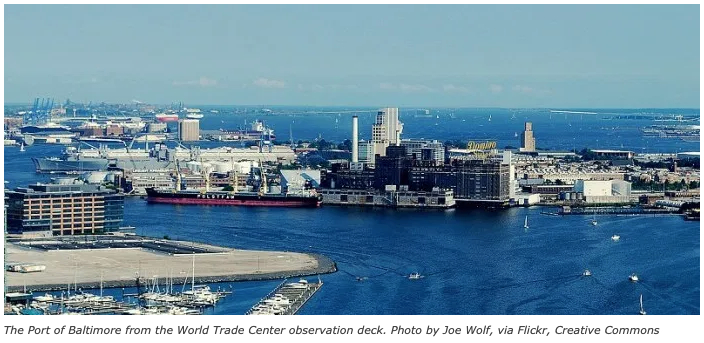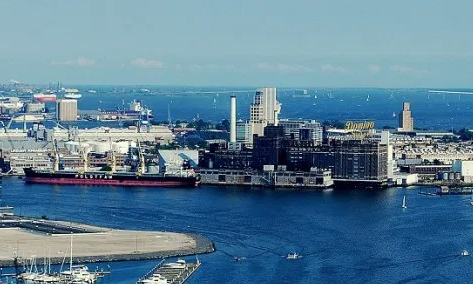 Officials at the Port of Baltimore, one of Maryland’s biggest economic assets, have acknowledged that sea levels are rising, but their efforts toward combating climate change are a work in progress.
Officials at the Port of Baltimore, one of Maryland’s biggest economic assets, have acknowledged that sea levels are rising, but their efforts toward combating climate change are a work in progress.
“We rely on the water,” said Kristen Fidler, director of the Office of Harbor Development at the Maryland Port Administration. She added that the administration realizes that with this reality “comes a lot of risks for the long-term viability” of the port.
The administration formally assessed its vulnerability to climate change in a 2010 report that was updated in 2017.
The assessment notes that some of the port’s facilities risk damage because of rising sea levels, storm surges and more frequent and severe storms.
The port focuses on flooding because of the assessment.
“It’s more of: How do we prevent flooding from impacting day-to-day business and preventing potential damage to people’s cargo,” said Jill Lemke, manager of strategic planning and special projects for the Maryland Port Administration.
Heat hasn’t been a problem for the port and therefore their climate change policies don’t focus on it, said Lemke and Richard Scher, spokesman for the Maryland Port Administration.
Though the port has policies in place for heat — supplying coolers for trucks, encouraging frequent breaks inside air conditioning and providing a public message board on the terminal that advises people if the heat index is above a certain level to stay hydrated — workers do not take days off for heat or any extreme temperatures.
“We are competing with other ports for cargo so we want to be sure that we are able to work in all type of weather,” Scher said.
The port created a climate resilience strategy in response to the climate change vulnerability assessment it conducted.
The strategy outlines how port officials plan to address climate change, including the projects they have already started working on and projects they would like to do in the future.
Lemke defines resilience as the port’s “ability to prepare for, adapt to and recover from significant climate-related threats or events with minimum damage and disruption to our operations, people inside and outside the port, the economy and the environment.”
The plan proposes a three-pronged model that includes either moving, elevating or strengthening structures and terminals.
So far the port has elevated some facilities as high as 10 feet to protect against flooding. The port also invested in an emergency generator, a forced main water vault, more durable concrete and a flood barrier system in an effort to manage flooding.
Lemke said these are “major climate resilience projects.”
Even though many projects have resilience benefits, the administration doesn’t have capital budget line items for specific climate resilience projects, Lemke said.
Before funds can be budgeted, the port has to analyze the cost associated with a particular project, she said.
“As a result we don’t have a figure to share,” Lemke said in an email to Capital News Service. “We recently submitted a Port Infrastructure Development Grant through the Maritime Administration of (the U.S. Department of Transportation), but nothing has been funded yet.”
Scher told CNS that there isn’t currently a “climate resilience” project that funds can be attached to.
“Right now we are building it into existing projects if we feel it’s necessary,” Scher said via email, “which would be reflected by added costs if there were any within a specific project but not a resilience project.”
Executive branch officials heaped praise on the port for its climate change efforts at the Maryland Board of Public Works meeting in October.
Maryland Comptroller Peter V.R. Franchot (D) called the port an “unbelievable, thundering economic success.”
Treasurer Nancy Kopp noted the port’s participation in the Maryland Commission on Climate Change, adding that the state is a “model” for its work in that area.
But Kopp told CNS after a November Board of Public Works meeting that she was “surprised” to hear that the Maryland Port Administration doesn’t have a budget line item dedicated specifically to climate change resilience.
“There ought to be,” Kopp said.
She clarified, however, that she knows the port is aware of the impact that rising sea levels and storm surge will have on its plans, adding that this awareness needs to be “embedded in everything they do.”
“They’re right on the water after all,” Kopp said.
One project for which the administration has made environmental efforts is the Masonville Dredged Material Containment Facility, which is the reason that port officials were at the Board of Public Works meeting in October in the first place.
Officials were seeking approval from the board to move forward with the third phase of the project.
Fidler was at the meeting. She said the facility receives sediment and other materials that are dredged from the shipping channels in the Baltimore harbor, which is “critical to the long-term sustainability of the harbor.”
Dredging is important to maintain the depth of the channels that ships use.
As part of efforts to mitigate the effects of the dredged material containment facility on the environment at Masonville Cove, Fidler said the administration “restored access to the water” for the community, created four acres of tidal wetlands and restored many more acres of marine habitats.
The efforts to clean up the cove were made in consultation with the Department of the Environment and the Army Corps of Engineers, she said.
The port is also replacing diesel engines in the port’s vehicles and equipment with more emission-efficient ones, according to the program’s website.
Del. David Fraser-Hidalgo (D-Montgomery) told CNS that he appreciates what the administration was doing with the program.
“I’m just sick of talking about clean coal, clean diesel,” Fraser-Hidalgo said. “… It’s all dirty.”
Scher said in an email that the program, which uses federal funds, covers forklifts, front loaders, trucks and other diesel equipment.
Fraser-Hidalgo, who is the chair of a transportation subcommittee on the House Environment and Transportation Committee, said that while he is not fully aware of what the Maryland Port Administration is doing in terms of climate change resilience, “everything should be on the table” with “all hands on deck.”
At the Board of Public Works meeting, Fidler said that the Masonville containment facility is just one part of the Maryland Port Administration’s 20-year plan for the “long-term placement capacity” of dredged materials.
She added, “It’s incumbent on us to be looking out beyond 20 years, with increased storm surges, storm events, potentially increased sedimentation, sea level rise, and those things.”
By JAZMIN CONNER and ELLIOTT DAVIS
Capital News Service/Howard Center for Investigative Journalism
Don’t miss the latest! You can subscribe to The Chestertown Spy‘s free Daily Intelligence Report here.



Write a Letter to the Editor on this Article
We encourage readers to offer their point of view on this article by submitting the following form. Editing is sometimes necessary and is done at the discretion of the editorial staff.